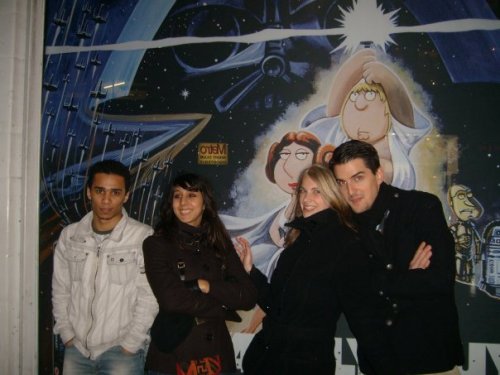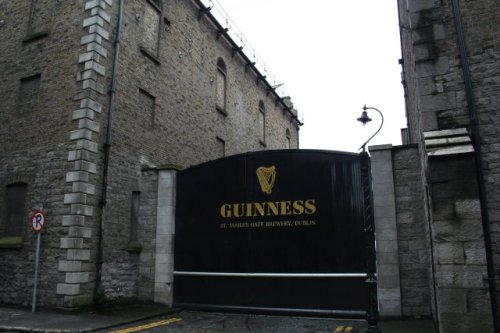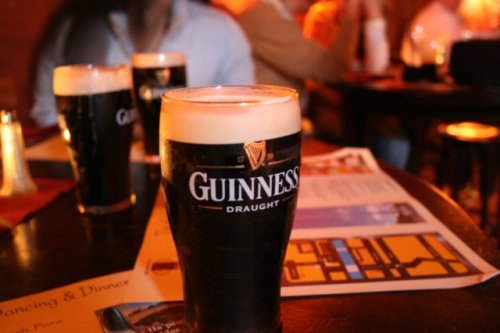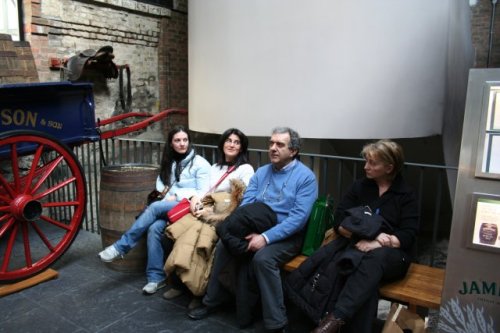Learning is a process that happens continuously during the lifetime. It makes us change and evolve, and it is inevitable. According to Bass and Vaughan (1966), learning is a relatively permanent change in behaviour that occurs as a result of practice and experience. Practice and experience influence us and provoke a change in the exposed behaviour when dealing with particular situations.
Learning can be accidental or guided. The difference between these two types of learning is that guided learning is an easier and more secure way of apprehending things. In the workplace people inevitably learn, and change, as a normal employee spends a big part of his time inside the organisation. As Neugarten (1968) said, work is one of the factors that provide the “major punctuation marks in the adult life”. What is the role of the organisation in an employee learning process? Is it accidental or not? Before answering these questions it is helpful to know how more about the learning process.
The learning process starts with a concrete experience, an event that triggers this process. Behaviourists give us their theories about the influence of these events. The reinforcement theory (or operant conditioning) declares that people’s behaviour produce consequences and how they behave in the future will depend on what those consequences are (Nye, 1992). According to this theory, people learn from feedback, not the event in itself, and therefore how the organisation structures this feedback is very important to how the organisation wants to guide their employees. The feedback can be presented or not and, in any case, the employee’s behaviour will be influenced by this. Presented reinforcing responses given by managers can be praise or promotion, or punishment. The first type of response is pleasant and it will encourage keeping this behaviour. The second type is an unpleasant response and it will discourage the behaviour. Similarly, withdrawing responses will have an impact on the learning process. Withholding a pleasant response to a behaviour will cause the extinction of that behaviour.
This type of learning is very practical, however it does not cover the acquisition of complex behaviours. Complex behaviours are adopted after a process of study, a process of internalisation of the information described by cognitive theories. Cognitive theorists say that learning is within the mind. Learners acquire understanding which they internalise, by being exposed to learning materials and solving problems (Armstrong, 2007). This is the main role of the mind in the reasoning and interpretation of the reality, at a conscious level.
An overall approach to the learning requires the use of all these theories together, because these theories are not exclusive: each explains a different learning situation. An attempt to see the process as a whole is presented in the experiential learning theory. This theory suggests that people learn by constructing their own schemas through experience. The relation between experience and thinking is explained in the Kolb learning cycle.
The idea of Kolb (1974) is that, while learning, an individual passes through a cyclic four stages process. First of all, an individual has a concrete experience, and from this they can extract information, observing what is happened and reflecting on the events. After having internalised the event, a person will try to draw a conclusion from this event, by creating some concepts and general rules that he think they are relevant to the situation. Hence, these general rules and understanding will be maintained organised for the application to a similar situation and, as soon as this situation occurs, applied. The application of these concepts to another event will make the individual have an experience that is different from the previous one and new information will be gathered for observation. Here the cycle starts again.
To learn effectively, individuals must shift from being observers to participants, from direct involvement to a more objective analytic detachment (Armstrong, 2007). This shift is not always smooth and easy, often individuals excel only when in a particular stage. An individual may be naturally inclined to observe and review experiences, but they may have problems when planning the next action to do. Therefore several styles can be distinguished, matching the four steps of the Kolb learning cycle: activist, reflector, theorist and pragmatist.
An activist will thrive on handling concrete experiences, such as little games or exercises, while he will be less benefited by situation involving passive roles, such as listening or reading. A reflector will need time to stand back from the reality and reflect on what has happened, they need time for themselves and rushing them will have a bad impact on their learning process. Theorists will do their best when the situation requires a formulation of abstract concepts and a generalisation of the case, seeing the big picture and consequently being able to apply their reasoning to similar cases. Theorists need structure to their thoughts, therefore they learn best when they review things in terms of schemas or models. Lastly, pragmatists have to relate their mental concepts to the reality, and they have problems when they do not see the connection between the proposed learning material and the reality.
These are the different learning styles distinguished by Honey and Mumford (1992). As evident from their explanation, people have a preference for a specific learning style, and they will encounter difficulties when passing through a phase of the cycle in which they do not excel. However, Kolb stressed the fact that the learning cycle has to be followed step-by-step for an effective learning, and, due to this, individuals have to be helped when traversing the stage in which they have problems.
For effective training, which is a perfect application of these techniques, trainers have to adjust their approach to the learning style of the trainees (Armstrong, 2007). They have to be aware of what is required from the students and give them the necessary support for the success of the programme. Students have to be guided through this process, and feedback from trainers and colleagues is necessary for an effective learning (Ribeaux & Poppleton, 1978).
As mentioned, the effectiveness of all these theories is shown during training sessions. However, learning theories can be also used for enhancing development programmes. Armstrong defines development as the growth or realisation of a person’s ability and potential through the provision of learning and educational experiences (2007). A correct application of learning styles and the learning cycle will determine the success of the development experience.
Employee development is also defined by Harrison with a slightly different connotation: “…is the skilful provision and organisation of learning experiences in the workplace so that performance can be improved… work goals an be achieved and through enhanced skill, knowledge, competencies, there can be continuous organisation as well as individual growth. Employee development must be part of a wider strategy for the business, aligned with corporate mission and goals” (1992).
Thus it is evident the need of link between business strategies, performance and development strategies. This is even more evident in the Matching model (Fombrun et al, 1984). In this model, vertical integration ensure that the right level of performance will be provided and will match the business strategies. In the same way, horizontal integration will ensure the match between the right level of skills, knowledge and competencies with the previously established required level of performance.
For instance, organisations with an innovation strategy will imply change inside the company, new ideas have to be expressed, knowledge have to be used and acquired continuously and, in this case, the correct set of skills have to be provided using training and development techniques if a certain level of performance have to be maintained.
In a similar way, development strategies are considered in the Harvard framework for human resource management (Beer et al, 1984). Development, training and all the other application of learning techniques are decided by HRM in their policies, according to the planned short and long term outcomes.
The difference between a successful development policy and an unsuccessful one is that the first is able to sustain itself after the starting event, and to continually grow and reach higher level of knowledge, skills or competencies. Mumford and Gold (2004) represents this with two different diagrams. An unsuccessful policy is identified by a vicious learning sequence, vitiated by lack of help while applying the knowledge at the workplace or the absence of gratification (reward). A successful policy will, on the other hand, focus directly on the topic taught so the teaching will be perceived as relevant and immediately applicable. Sources of help will be available to the individual, such as counselling services, and the successful application will be rewarded, so the trainee will be satisfied and enthusiast to learn more.
Successful learning policies will promote learning in organisations, and they will stimulate the employees to find their way through these learning cycles, achieving higher and higher levels of development, transforming the cycle into a spiral, a spiral that as each cycle expands more and more, embracing more knowledge and letting the trainee know how to deal with more situations, each time with a slightly different range of details.
There are various type of learning in an organisation: the learning of an individual occurs with informal and formal learning, self-managed or guided, involuntary or voluntary. Each of these has its own advantages and disadvantages, and the best solution is to find a compromise between the different methods. Examples of informal learning is the experiential learning, that often happens by trial and error. The advantage is that the learning is readily transferable to the situation. Experiential learning is often self-managed and not always effective. A more guided but not excessively formal is coaching/mentoring approach, that consists of assisting the employee via a tutor that guides him through the process. This type of learning is supported, it maintains the advantages of the experiential learning. The coach is seen as a facilitator of the learning process. Structured training programmes, on the other hand, are a formal and standardised way to apprehend, however the main disadvantage is that the transferred knowledge can be relevant to some, but not so relevant to others, and, in addition to this, problems may occur in applying learning to the workplace (Armstrong, 2007).
A balanced approach can be a mix of different learning strategies, creating the right combination is necessary for taking advantage of the positive aspects of each learning delivery method. Often applied in training, there is a practice called blended learning. As defined by Sloman (2003), blended learning is an approach to training design that involves the use of a combination of delivery methods and in some cases learning methodology. Therefore blended learning consists of delivering learning using different ways, from informal learning to structured training courses, passing through all the range of different methodologies.
The first step for the promotion of learning by HR specialists is to be aware of the learning theories, learning cycles, styles and learning delivery methods. However it is also important to understand what motivates people to learn. The organisation must transmit the need of development, to make their employees feel that their present level of skills, knowledge or competence needs to be developed if they want to be satisfied by their performance. The satisfaction is a key element, without support and rewards the learner will be left unsatisfied and he will stop learning. Learning is usually driven by the expectation of achieving something desiderable (Vroom, 1964). This can be a financial reward, or something that make the individual grow as a person (e.g. increasing in skills or competencies), or simply an increase in employability of the individual. As Kanter said, employability is the “new security” (1989).
In companies when the learning is a key element of the business strategy, it has to be pursued by intelligently applying the learning theories and techniques described previously. The learning organisation is an organisation that facilitates the learning of all its members and consciously transforms itself and its context (Pedler et al, 1997), and it is the type of organisation in which learning and business strategy are closely related. Senge (1990) and Garvin (1993) gave us some rules about how to build a learning organisation, such as focus on collective, systematic problem-solving, encouraging self-directed learning and experimentation, implement virtuous learning cycles and store the learning in knowledge management systems, avoiding committing the errors of the past. Benchmarking practices (learning from others) are also encouraged. No models are present to help the construction of the learning organisations, only a set of guidelines. In fact, it is mainly for this that the concept of learning organisations have been criticised for a long time. Lack of clarity, lack of detailed implementations and lack of complete research are just a few of the reasons, considered by Lähteenmäki (1999), why the learning organisation is more utopian than real.
CONCLUSION
Learning is a continuous process, it does not stop during the whole lifetime. It can be accidental or guided, but however it always brings change to the individual. Learning happens in several ways: through reinforcement responses, through direct experience or simply by observing and imitating others. Another important way of learning is by cognition. Feedback mechanisms are evident in reinforcement learning, but in all these modalities it is important for the learner to receive feedback when trying to apply what he has been learning to the reality. Learning through experience is a very good way to apprehend new knowledge and fix it in the memory. The idea of the learning cycle (Kolb, 1974) shows us that an effective learning has to pass through four stages: experience, reflection, theorisation and application of the acquired theories. Each individual has a particular learning style, and this means that he tend to be better in one stage than another. The organisation has to make sure that when the employee encounters difficult stages, he will be helped to pass it and go further. Learning is present in the organisation in various forms: development, training, and other less used forms. To be effective, the learning processes have to be integrated into the HR policies of the organisation. As mentioned, it is possible to frame the learning process into some of the HR functioning models such as the Matching model or the Harvard model. In the Matching model, development policies are created and adjusted accordingly to the level of performance requested. A successful learning policy will auto-sustain itself when put into action, because the policy will also provide rewards and the opportunity to ask for support, transforming the learning process into continuous cycles. A successful policy will also provide various means of learning, because there is no best way to provide learning, especially considering that people learn in different ways from each other. Thinking over all this material the organisation should be able to elaborate an effective program and promote it in the right way into its working environments.
REFERENCES
Armstrong, M. (2007). A Handbook of Human Resources Management Practice (10th ed). London: Kogan Page.
Bass, B. M. & Vaughan, J. A. (1966). Training in industry: The management of learning. London: Tavistock.
Beer, M., Spector, B., Lawrence, P., Quinn Mills, D. & Walton, R. (1984). Managing human assets. New York: Free Press.
Fombrun, C. J., Tichy, N. M. & Devanna, M. A. (1984). Strategic Human Resource Management. New York: Wiley.
Garvin, D. A. (1993). Building a Learning Organisation. Harvard Business Review, July- August, pp 78-91.
Harrison, R. (1992). Employee Development. London: Institute of Personnel Management.
Honey, P. & Mumford, A. (1992). The manual of Learning Styles (3rd ed). Maidenhead: Honey Publications.
Kanter, R. M. (1989). When giants learn to dance. New York: Simon & Schuster.
Kolb, D. (1974). Organizational Psychology: An Experiential Approach. Englewood: Prentice-hall.
Lähteenmäki, S., Holden, L. & Roberts, I. (1999). HRM and the Learning Organisation. Turku: Turku School of Economics and Business Administration.
Mumford, A. & Gold, J. (2004). Management Development: Strategies for Action. London: Chartered Institute of Personnel and Development.
Neugarten, B. L. (1968). Adult Personality: Toward a Psychology of the Life Cycle, in Neugarten BL (ed) Middle age and aging: A Reader in Social Psychology. Chicago: University of Chicago Press.
Nye, R. D. (1992). The Legacy of B.F.Skinner: Concepts and Perspectives, Controversies and Misunderstanding. Belmont: Brooks/Cole.
Pedler, M., Burgoyne, J. & Reynolds, T. (1997). The Learning Company. London: McGraw-Hill.
Ribeaux, P. & Poppleton, S. E. (1978). Psychology and Work: An Introduction. London: MacMillan.
Senge, P. (1990). The Fifth Discipline: The Art & Practice of the Learning Organisation. London: Century.
Sloman, M. (2003). Training in the Age of the Learner. London: CIPD.
Vroom, V. (1964). Work and Motivation. New York: Wiley.
Read Full Post »




































